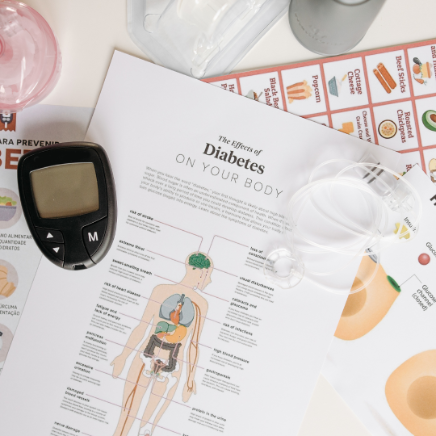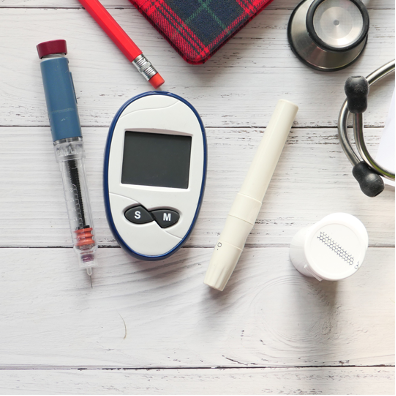Course
Continuous IV Insulin Therapy
Course Highlights
- In this Continuous IV Insulin Therapy course, we will learn about the principles and implementation of continuous IV insulin therapy.
- You’ll also learn patient populations and scenarios that benefit from this therapy.
- You’ll leave this course with a broader understanding of evidence-based practices and guidelines for effective therapy management.
About
Contact Hours Awarded: 2
Course By:
Kimberlee Emfield Rowett, DNP, MSN, MBA, RN
Begin Now
Read Course | Complete Survey | Claim Credit
➀ Read and Learn
The following course content
Introduction
Continuous intravenous (IV) insulin therapy involves the administration of insulin through an IV line at a constant, controlled rate. Continuous IV insulin therapy aims to achieve precise blood glucose management. This administration can be utilized in acute or critical situations. It is different from intermittent insulin administration, such as insulin bolus, because continuous IV insulin therapy provides a steady infusion of insulin to maintain a stable, predictable blood glucose level.
The primary purpose of continuous IV insulin therapy is to manage severe hyperglycemia. When insulin is used properly, it can effectively mimic the natural and continuous release of insulin from the pancreas. The release of insulin, or the use of insulin therapy, helps maintain blood glucose levels in a narrow target range necessary to prevent medical complications and adverse events. Continuous infusions allow for rapid adjustments in real time based on blood glucose measurements. Therefore, continuous IV insulin therapy is the ideal treatment for patients with fluctuating insulin needs.
Indications for Use
There are various medical indications for insulin therapy. A few clinical indications include diabetic ketoacidosis (DKA), hyperosmolar hyperglycemic state (HHS), perioperative glucose control, and various critical illnesses.
- Diabetic Ketoacidosis (DKA) is a severe complication of diabetic patients that includes symptoms of hyperglycemia, ketonemia, and metabolic acidosis.
- This occurs when insufficient insulin is found in the body, causing elevated blood glucose levels and the use of fat for energy. In this process, ketones are created which ultimately leads to ketonemia.
- Continuous IV insulin therapy can rapidly correct hyperglycemia and ketonemia. These adjustments lead to better glucose levels and better electrolyte balances, as well as address the prevention of dehydration (1).
- Hyperosmolar Hyperglycemic State (HHS) is an acute complication of diabetes leading to elevated blood glucose levels, severe dehydration, and increased serum osmolality without ketoacidosis.
- This complication most commonly occurs in type 2 diabetics and infection, illness, or medication non-compliance can be the catalyst for this medical condition.
- Continuous IV insulin therapy assists with gradually lowering the blood glucose levels without contributing to dehydration and electrolyte imbalance.
- This approach also reduces the challenges of cerebral edema and cardiovascular issues.
- Perioperative Glycemic Control occurs before and after major surgeries and medical procedures in attempts to reduce postoperative complications.
- Stress and fasting associated with surgery can lead to fluctuations in blood glucose levels. However, the use of continuous IV insulin therapy can provide precise glucose management. Adjusting insulin infusion rates to meet the blood glucose levels before and after surgeries and their associated stress levels helps reduce complications, improves wound healing, and reduces the risk of infection
- Critical Illness impacts blood glucose levels, impacting patients recovering in intensive care units (ICUs).
- While all critical illnesses put patients at risk, ICU patients are in critical condition, making blood glucose levels necessary to monitor closely for a variety of reasons.
- Glucose metabolism can be altered due to stress, inflammation, and illness. Glycemic control assists with improving outcomes and reducing the risk of complications.
- Close monitoring and adjustment of insulin therapy should be considered for the changing clinical conditions of these critically ill patients.
Continuous IV insulin therapy is vital in managing severe hyperglycemia and complex clinical conditions. Providing precise glucose monitoring and insulin administration allows for optimal glycemic control, leading to improved patient outcomes. Continuous IV insulin therapy can be applied in a variety of clinical situations, including conditions of DKA, HHS, perioperative management, and critical illness.

Self-Quiz
Ask Yourself...
- How does continuous IV insulin therapy compare to intermittent insulin administration?
- How does the use of continuous IV insulin therapy in conditions like DKA or HHS impact patient outcomes?
- What potential challenges does continuous IV insulin therapy create in the critical care setting?
- Can you discuss specific critical illnesses that impact blood glucose levels?
Definition
Continuous IV Insulin Therapy is defined as the administration of insulin via intravenous (IV) infusion at a constant and controlled rate. This method is used to provide precise and steady insulin delivery, which is necessary for the management of severe hyperglycemia. The purpose of continuous IV therapy is to mimic the natural and continuous release of insulin from the pancreas to create a stable blood glucose level.
The benefits of stable blood glucose include a reduction of fluctuations and reduces the risk for either hyper- or hypoglycemia. Continuous IV insulin therapy also allows for rapid adjustments, providing flexibility in clinical situations where blood glucose is not currently under control. Additionally, continuous infusion allows for a more precise administration of insulin as compared to intermittent injections or boluses.
Remember, clinical indications for continuous IV insulin therapy include Diabetic Ketoacidosis (DKA), Hyperosmolar Hyperglycemic State (HHS), perioperative management, and critical conditions.
DKA is a severe complication characterized by high blood glucose levels, leading to an increase in ketone production, and causing a state of metabolic acidosis in the patients. Continuous IV insulin helps correct the imbalances associated with DKA, both quickly and effectively. HHS occurs when a patient has an incredibly high blood glucose level in combination with severe dehydration. This typically occurs in type 2 diabetics. Continuous IV insulin therapy helps reduce blood glucose levels and manages the related complications.
Perioperative management is necessary for patients with blood glucose control concerns. Precise glucose control reduces the risk of surgical complications, including poor wound healing, infection development, or more severe cases, sepsis. Critical illness is also a serious situation where blood glucose control is necessary. For those in critical condition, continuous IV insulin therapy provides tight glucose control to ensure metabolic stability and improved patient outcomes (2).


Self-Quiz
Ask Yourself...
- How does the standardization of continuous IV insulin therapy protocols improve patient safety?
- In what ways can patient feedback influence the management of continuous IV insulin therapy?
- How can data-driven decision-making be optimized to improve outcomes in continuous IV insulin therapy?
Assessment
Assessing patients for continuous IV insulin therapy starts with an initial assessment. This initial assessment includes assessing glucose and ketone levels, the overall metabolic state, and reviewing the patient’s medical history. Glucose levels provide an accurate assessment of the patient’s current needs for IV insulin therapy, where ketone levels can be used to identify the intensity of insulin therapy necessary. The overall metabolic state of a patient will include electrolyte balance, renal function, and acid-base balance. This assessment ensures all aspects of the patient’s condition are considered when administering continuous IV therapy. Finally, a patient’s medical history can identify if diabetes is a current diagnosis, as well as other co-morbidities and other conditions that may complicate insulin therapy (3).
Monitoring and adjusting insulin therapy is the next step in this process. Continuous IV insulin therapy needs rigorous monitoring and adjustment based on real-time data (4). These include continuous glucose monitoring, patient response, and adjustment protocols.
Continuous glucose monitoring can be accomplished by continuous glucose monitoring (CGM) devices. These devices are secured to the patient’s body and analyze the patient’s blood glucose level in real-time. Patient response to insulin therapy should also be assessed. Assessing whether a patient is responding to the given insulin therapy can help identify and predict severe fluctuations in blood sugar levels. These extreme fluctuations can lead to hyper- or hypoglycemia. Using these items, adjustments can be made. Adjustment protocols help maintain glycemic stability and adjust according to patients’ needs and conditions.

Self-Quiz
Ask Yourself...
- How does real-time information impact continuous IV insulin therapy?
- How does continuous IV insulin therapy provide more precise insulin delivery than intermittent injections?
- What are the benefits and drawbacks of continuous IV insulin therapy?
Assessment Tools
Assessment tools for continuous IV insulin therapy include continuous glucose monitors (CGMs), insulin infusion pumps, and blood glucose meters. CGMs measure a patient’s glucose levels in the interstitial fluids. This provides real-time data that helps adjust insulin infusion rates accordingly (5). Insulin infusion pumps can be used via IV, while others provide insulin into the subcutaneous skin. CGMs can interface with the pump to improve glucose management. Blood glucose meters can also be used to periodically check and validate the accuracy of CGMs.
Insulin infusion rates and effectiveness should also be assessed. Glucose trends, clinical assessments, adjustments, and fine-tuning, as well as documentation and review, can aid in the success of IV insulin therapy. Consistent glucose readings within the target ranges can indicate that current insulin infusion rates are appropriate. Regular clinical assessments, including checking for hypoglycemia and hyperglycemia symptoms, can indicate patients’ overall well-being. Adjustments and fin-tuning based on this clinical data can ensure corrections are made for acute changes in a patient’s condition. Finally, appropriate documentation and review help track therapy progress and adherence to treatment protocols.


Self-Quiz
Ask Yourself...
- How do CGMs and insulin infusion pumps enhance the effectiveness of insulin therapy?
- In what ways do periodic checks with traditional glucose monitors impact the overall accuracy of insulin therapy?
- What are the implications of relying on glucose trends and clinical assessments for fine-tuning insulin infusion rates?
Epidemiology
There are various indications for continuous IV insulin therapy. The common conditions that require continuous IV insulin therapy include severe hyperglycemia, diabetics ketoacidosis, and hyperosmolar hyperglycemic state. Continuous IV insulin therapy is commonly utilized for patients in intensive care units (ICU), or emergency departments related to its effectiveness in managing severe metabolic conditions. Continuous IV insulin therapy improves glycemic control in critically ill patients, improving the resolution of hyperglycemia. This control leads to improved patient outcomes and reduced time in the ICU. Various factors impact the effectiveness of continuous IV insulin therapy, including age, comorbidities, and the underlying health condition (6). These factors need to be considered when caring for patients receiving continuous IV insulin therapy.

Self-Quiz
Ask Yourself...
- How might variability in patient populations affect the effectiveness of continuous IV insulin therapy?
- How does continuous IV insulin therapy integrate with other components of the patient’s comprehensive care plan?
- Why does relying solely on continuous IV insulin therapy for managing severe hyperglycemia impact patient care?
Clinical Signs and Symptoms
Clinical signs and symptoms should be closely monitored for patients needing continuous IV insulin therapy. The symptoms of severe hyperglycemia, DKA, and HHS can indicate if continuous IV insulin therapy is successful or requires adjustment. If symptoms are better managed, then current infusion rates can continue as ordered. However, if symptoms of severe hyperglycemia, DKA, and HHS are not improving or worsening, adjustments may be indicated.
Symptoms of sever hyperglycemia include high blood glucose levels, polyuria, polydipsia, blurred vision, and fatigue. Depending on severity, glycosuria and dehydration may occur (7). Continuous IV insulin therapy may be indicated when hyperglycemia becomes severe and unmanageable with oral medication or subcutaneous (SQ) insulin.
Symptoms of diabetic ketoacidosis (DKA) include nausea, vomiting, abdominal pain, Kussmaul respirations, fruity-smelly breath, confusion, and lethargy. Dehydration and altered levels of consciousness may also be observed. DKA requires continuous IV insulin therapy to rapidly reduce blood glucose levels, correct ketoacidosis, and manage electrolyte imbalances (8).
Hyperosmolar hyperglycemic State (HHS) is indicated by signs and symptoms of sever dehydrations, altered mental status, profound weakness, and even seizures. High serum osmolality and elevated blood glucose levels are key diagnostics for this diagnosis. Continuous IV insulin therapy is needed for HHS to gradually lower blood glucose levels, restore fluids, and improve electrolyte balance (9).

Self-Quiz
Ask Yourself...
- How can differentiating symptoms of hyperglycemia, DKA, and HHS guide the decision to start continuous IV insulin therapy?
- How does continuous glucose monitoring data influence the identification of insulin resistance?
- What might be some consequences of not responding promptly to change sin a patient’s condition while on continuous IV insulin therapy?
Etiology
It is also important to understand the etiology of these conditions that lead to the need for continuous IV insulin therapy. Diabetic ketoacidosis (DKA) can be caused by insulin deficiency, infection, and medication noncompliance. Hyperosmolar hyperglycemic state (HHS) can be caused by severe dehydration, chronic hyperglycemia, and other underlying illnesses. Similarly, inadequate insulin production can lead to HHS (10). Other contributing factors include infection, medication non-compliance, and physiological stress.


Self-Quiz
Ask Yourself...
- How do different underlying causes of diabetic ketoacidosis (DKA) and hyperosmolar hyperglycemic state (HHS) impact continuous IV insulin therapy?
- How does continuous IV insulin therapy address both the symptoms and the underlying causes of severe hyperglycemia?
Treatment
Setting up and managing the continuous IV insulin infusion involves attention to detail. First, equipment must be prepared. Gathering the necessary supplies should include the infusion pump, infusion set, and appropriate IV fluids. The insulin solution must be prepared by diluting regular insulin with the compatible IV fluids according to the prescription. Then the insulin pump must be configured according to the correct infusion rate. A calculation may occur based on the patient’s weight, height, insulin sensitivity, and diagnosis (11.).
Dosing strategies may include an initial dose, or loading dose, and the maintenance dose. The initial dose is used to rapidly bring the blood glucose level back into range, while the maintenance dose is set to keep the blood glucose level stable after it has reached the identified target (12). Additional adjustments may be made after glucose monitoring data is observed and assessed. Similarly, observing the clinical response can help identify if the patient is responding without extreme fluctuations in blood glucose levels.

Self-Quiz
Ask Yourself...
- How does the initial dosing strategy impact the effectiveness of continuous IV insulin therapy?
- How can real-time glucose monitoring data inform adjustments to insulin infusion rates?
Self-Management
While understanding the continuous IV insulin therapy is necessary for the nurse, it is just as important for the patient and family to understand this treatment modality. Educating patients and families about continuous IV insulin therapy should involve the basics of how this treatment works, why it is used, and what the goals of this treatment are. Also reviewing the benefits of this type of treatment can help the patient and their family to better understand why it was chosen as well as the importance to remain compliant with the treatment plan supporting continuous IV insulin therapy (13).
If a patient is being discharged from the hospital with orders to continue continuous IV insulin therapy at home, education should be provided surrounding home care protocols, emergency signs and symptoms, as well as procedures. There should also be a set follow-up appointment and regular communication (7).
Beyond providing the patient and their family with the next steps, it is important to assess and address any barriers to care. This may include patient education programs, support groups, financial and logistical support, among other interventions. It is the nurse’s role to aid in ongoing education, personalized support, treatment adherence support, as well as emotional support.

Self-Quiz
Ask Yourself...
- How does understanding the underlying principles of continuous IV insulin therapy impact a patient’s ability to manage their treatment effectively at home?
- In what ways can healthcare professionals tailor their support and educational strategies to meet the unique needs of patients transitioning from hospital to home care for continuous IV insulin therapy?
- What are some potential barriers to effective self-management of continuous IV insulin therapy at home, and how can these barriers be addressed through patient education and support systems?
Research Findings
Recent advancements in continuous IV insulin therapy have occurred in relation to the technological and medical advancements found recently. Improvements in infusion pumps offer features such as integrated continuous glucose monitoring (CGM) systems. This allows for real-time data interpretation and decision making (14).
There are also smart insulin delivery systems, which leverage algorithms to predict glucose levels and necessary insulin delivery proactively (15). Similarly, there have been improvements in the CGM technology available. Newer CGMS provide more precise glucose readings, have longer wear times, and contribute to more reliable insulin management.
Beyond these advancements, the utilization of artificial intelligence can also provide further enhancements through machine learning and AI algorithms. The use of biomarkers means we can now predict insulin sensitivity in our patients to allow for more accurate dosing. As mentioned previously, wearable technology has advanced. Al of these advancements lead to better patient outcome through enhanced effectiveness of treatment.


Self-Quiz
Ask Yourself...
- How do recent technological advancements in insulin infusion systems influence the effectiveness of continuous IV insulin therapy?
- What are the implications of integrating artificial intelligence into continuous IV insulin therapy, and how might this integration affect patient outcomes?
- In what ways could emerging research on biomarkers and wearable technology change the landscape of continuous IV insulin therapy in the future?
- Are you familiar with AI platforms?
Conclusion
Continuous IV insulin therapy plays a pivotal role in managing severe hyperglycemia and acute conditions such as diabetic ketoacidosis (DKA) and hyperosmolar hyperglycemic state (HHS). By providing precise and stable insulin delivery, it ensures tighter glycemic control and minimizes the risks associated with significant glucose fluctuations.
The therapy’s ability to adjust in real-time based on continuous glucose monitoring makes it indispensable in critical care settings. Ensuring that practices are aligned with the latest evidence and guidelines helps in maintaining high standards of care and improving patient safety.
References + Disclaimer
- Wang, J., Wu, X., & Zhang, J. (2022). The role of continuous intravenous insulin therapy in managing diabetic ketoacidosis: An updated review. Diabetes Research and Clinical Practice, 183, 109120. https://doi.org/10.1016/j.diabres.2021.109120
- Pérez, Antonio MD, PhD1,2,3, *; Ramos, Analia MD, PhD1,2; Carreras, Gemma MD, PhD2,4. Insulin Therapy in Hospitalized Patients. American Journal of Therapeutics 27(1):p e71-e78, January/February 2020. https://journals.lww.com/americantherapeutics/abstract/2020/01000/insulin_therapy_in_hospitalized_patients.8.aspx
- Umpierrez, G., & Korytkowski, M. T. (2020). Diabetic ketoacidosis and hyperglycemic hyperosmolar state: Diagnosis and management. American Diabetes Association. https://doi.org/10.2337/dci20-0003
- Korytkowski, M. T. (2020). Management of hyperglycemia in hospitalized patients: Current guidelines and best practices. Diabetes Care, 43(9), 2280-2290. https://doi.org/10.2337/dc20-1370
- Battelino, T., Danne, T., Bergenstal, R. M., & Garg, S. K. (2019). Continuous glucose monitoring: A consensus conference report. Diabetes Care, 42(6), 1200-1214. https://doi.org/10.2337/dci19-0015
- Kowalski, T. J., & Fox, S. D. (2019). “The impact of continuous intravenous insulin therapy on patient outcomes in the ICU.” Critical Care Medicine, 47(1), 101-107. https://doi.org/10.1097/CCM.0000000000003415
- American Diabetes Association. (2021). Standards of medical care in diabetes—2021. Diabetes Care, 44(Supplement 1), S1-S232. https://doi.org/10.2337/dc21-S001
- Kitabchi, A. E., Umpierrez, G., Miles, J. M., & Fisher, J. N. (2009). Hyperglycemic crises in adult patients with diabetes. Diabetes Care, 32(7), 1335-1343. https://doi.org/10.2337/dc09-9036
- Morrison, C., & McFadden, R. (2020). Hyperosmolar hyperglycemic state: An update. Journal of Clinical Endocrinology & Metabolism, 105(4), 1228-1235. https://doi.org/10.1210/jc.2020-00237
- Munro, S., & Lunt, H. (2021). A review of the management and outcomes of hyperosmolar hyperglycemic state. Diabetes Research and Clinical Practice, 175, 108725. https://doi.org/10.1016/j.diabres.2021.108725
- Brouwers, M. C., Govers, A., & Huitema, M. (2020). The role of continuous insulin infusion in managing critical care patients. Critical Care Medicine, 48(3), 453-460. https://doi.org/10.1097/CCM.0000000000004155
- Cryer, P. E., & Davis, S. N. (2020). Glucose monitoring and insulin infusion management. Endocrine Practice, 26(9), 1015-1024. https://doi.org/10.4158/EP-2020-0382
- Korytkowski, M. T., & Umpierrez, G. (2020). Patient and family education for insulin therapy in the management of diabetes. Endocrine Practice, 26(7), 743-750. https://doi.org/10.4158/EP-2020-0051
- Buse, J. B., Garg, S. K., & Rosenstock, J. (2022). Advancements in continuous intravenous insulin infusion technology: Enhancing precision and patient outcomes. Journal of Diabetes Science and Technology, 16(1), 15-27. https://doi.org/10.1177/19322968211051008
- Jones, T. E., Young, J. B., & Alexander, P. (2023). Smart insulin delivery systems: The future of personalized glucose management. Diabetes Technology & Therapeutics, 25(2), 103-112. https://doi.org/10.1089/dia.2022.0262
Disclaimer:
Use of Course Content. The courses provided by NCC are based on industry knowledge and input from professional nurses, experts, practitioners, and other individuals and institutions. The information presented in this course is intended solely for the use of healthcare professionals taking this course, for credit, from NCC. The information is designed to assist healthcare professionals, including nurses, in addressing issues associated with healthcare. The information provided in this course is general in nature and is not designed to address any specific situation. This publication in no way absolves facilities of their responsibility for the appropriate orientation of healthcare professionals. Hospitals or other organizations using this publication as a part of their own orientation processes should review the contents of this publication to ensure accuracy and compliance before using this publication. Knowledge, procedures or insight gained from the Student in the course of taking classes provided by NCC may be used at the Student’s discretion during their course of work or otherwise in a professional capacity. The Student understands and agrees that NCC shall not be held liable for any acts, errors, advice or omissions provided by the Student based on knowledge or advice acquired by NCC. The Student is solely responsible for his/her own actions, even if information and/or education was acquired from a NCC course pertaining to that action or actions. By clicking “complete” you are agreeing to these terms of use.
➁ Complete Survey
Give us your thoughts and feedback
➂ Click Complete
To receive your certificate
